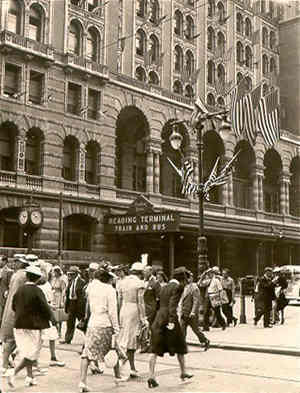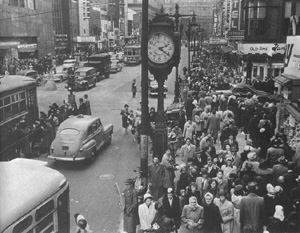

The Reading Terminal is located in an area of downtown Philadelphia known today as "Market East": the stretch of Market Street "east" of Broad Street. During the late-19th and early-20th centuries, Philadelphia's manufacturing economy was booming and its population growing rapidly. On Market Street, large buildings of more sophisticated design replaced some of the older low-rise commercial structures. The intersection of 12th and Market Streets—one of the most active spots in the Philadelphia area—was a hub of transportation, shopping, and business.
Completed in 1893, the Reading Terminal was the principal station of the Philadelphia & Reading Railroad (soon to be reorganized as the Reading Company). The new station consolidated passenger services from three old depots, located in less central parts of the city. Its Italian Renaissance-style head house (at the "head" of the tracks) was designed by Francis H. Kimball and contained the railroad's offices on the upper floors and retail enterprises in the half-basement. From its second-floor waiting room, throngs of people walked a wide, skylit concourse to reach the cavernous train shed, designed by the Wilson Brothers and Company, where long-distance and local trains were loading and unloading passengers. Below the tracks, which were carried into the station on a viaduct, the Reading Terminal Market sold a bounty of meat and produce.
After
the mid-20th century, the gradual demise of the Reading Company and the
weakening of downtown as a shopping-and-office center reduced the vitality
of the 12th-and-Market-Streets area. The Reading Terminal, among other
buildings, was in jeopardy. From the vision of urban planner Edmund Bacon,
Market East began to reposition itself for success in a different economy—starting
with the construction of a railroad tunnel and urban shopping mall ("The
Gallery," I and II), and later, with development of the publicly
financed Pennsylvania Convention Center and entrepreneurs' ventures into
a corresponding hospitality industry. Restored and reconfigured buildings,
such as the Reading Terminal (a designated National Historic Landmark)
serve as anchors and give character to the redefined area of Market East.
![]()
![]()

Crowds on Market Street, c. 1940.

12th
& Market Streets looking toward PSFS Building, 1950s.
TOP • NEXT PAGE • LIST OF TOUR STOPS • MAP • P.N.R.T. HOME • YOUR COMMENTS